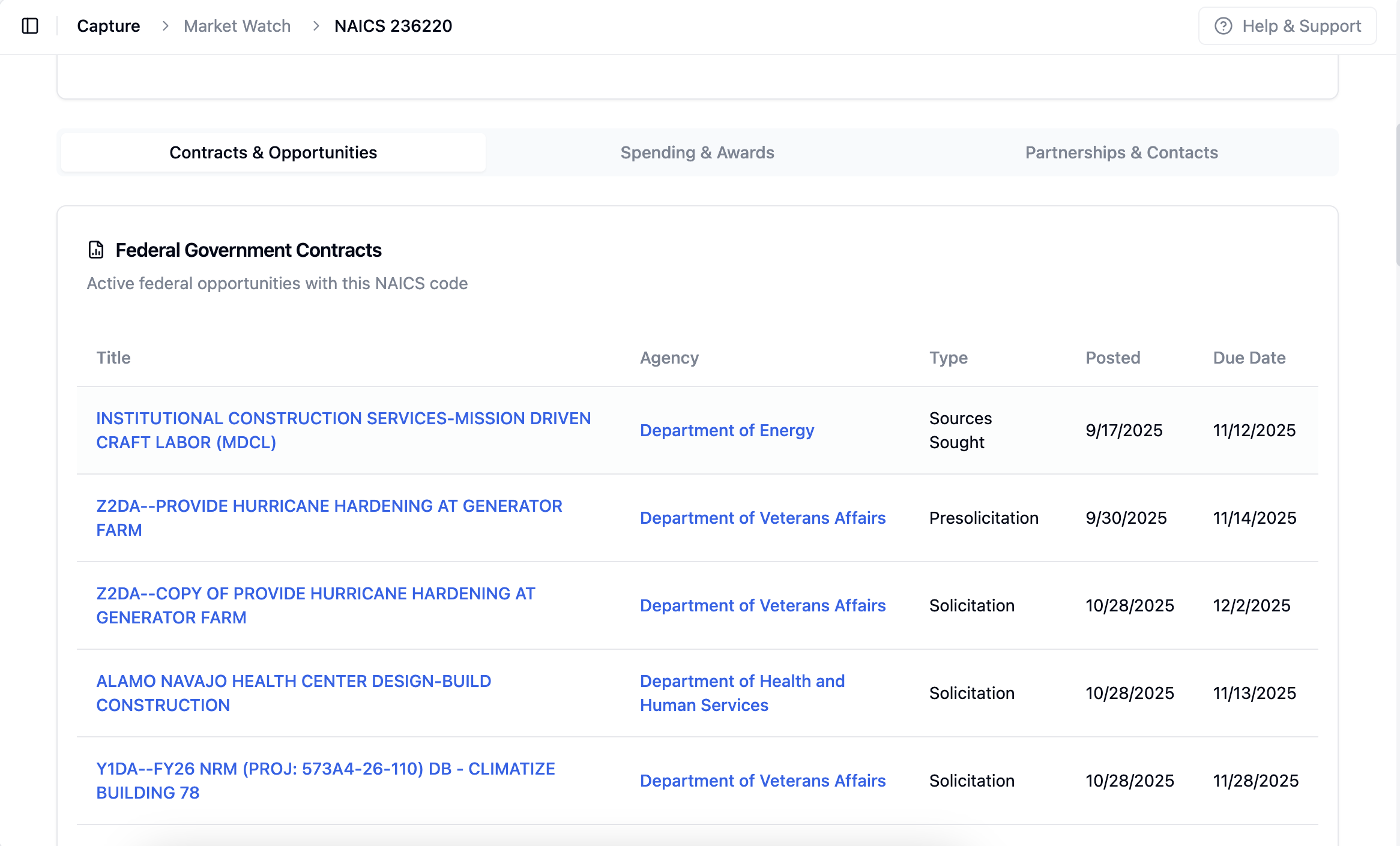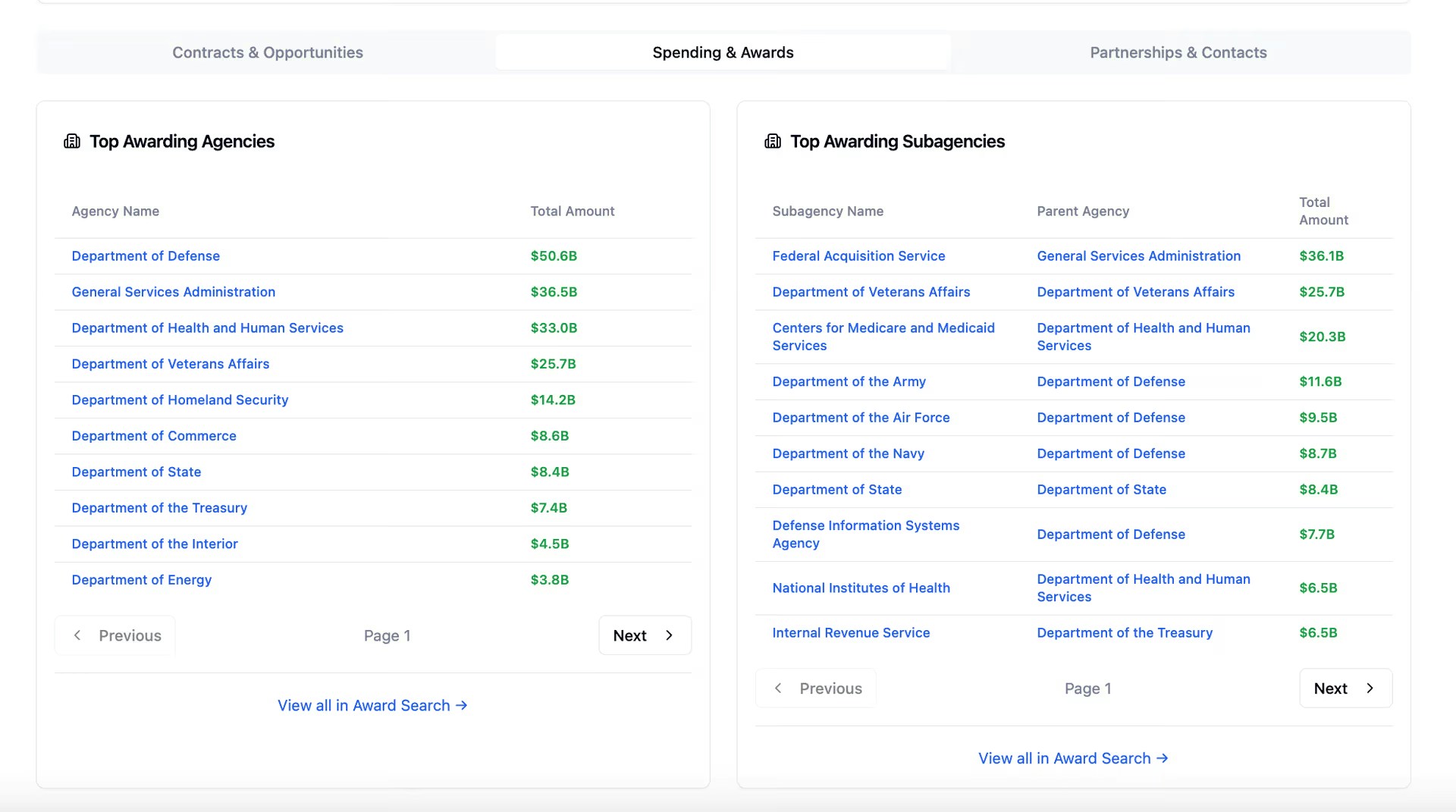
Overview
Market Watch provides real-time intelligence on federal contract activity, allowing you to:- Monitor live contract activity and spending trends
- Identify key agencies, buyers, and contracting officers
- Track competitor activity and prime contractors
- Discover teaming partners and subcontracting opportunities
- Analyze historical patterns and forecast future opportunities
- Find expiring contracts for recompete positioning
Getting Started
How to Use Market Watch
1
Select Your Market
Choose a NAICS code, PSC code, or search for a specific federal agency
2
View Analytics
Click “View Analytics” to access market intelligence and spending data
3
Explore Opportunities
Review contracts, spending trends, and key decision makers
4
Find Partners
Identify prime contractors and teaming opportunities
5
Build Relationships
Use contact information to engage with buyers proactively

What You’ll Find
Active Federal Contracts
View currently active federal opportunities matching your selected NAICS code, PSC code, or agency criteria.
Subcontracting Opportunities
Browse active subcontracting opportunities with prime contractor details and partnership prospects.Forecast Opportunities
Access forecasted federal opportunities with estimated release dates and projected contract values.Expiring Contracts (6-12 Months)
Identify prime recompete opportunities before they’re publicly announced. View contract expiration dates, incumbent contractors, and agency transition plans to position yourself during the pre-solicitation period.Market Intelligence Features

Real-Time Contract Activity Monitoring
Track live contract activity and spending trends across federal agencies as they unfold.Top Contracting Agencies & Subagencies
Identify the highest-spending agencies and subagencies in your market to focus your business development efforts.Prime Contractors & Teaming Partners
Discover prime contractors and potential teaming partners actively winning contracts in your space.Competitor Activity & Intelligence
Monitor competitor activity and market positioning. See what your competition is winning and where they’re focusing to inform your strategy for teaming, subcontracting, or going direct.Agency Buyer & Contracting Officer Contacts
Access direct contact information for agency buyers and contracting officers across all government agencies and subagencies.Historical Patterns & Forecast Data
Analyze historical spending patterns and forecast data to predict future opportunities and market trends.Understanding Organizational Levels

Agency Level
Examples: Department of Defense, Department of Homeland Security, Department of Veterans Affairs, General Services Administration Use this level to: Understand macro spending trends and policy priorities across entire departments.Subagency Level
Examples: Army, Navy, Air Force, Space Force, CBP, TSA, FEMA, ICE, IRS, FBI, NASA, NOAA, EPA Use this level to: Target specific mission areas and understand unique procurement requirements.Office Level
Examples: Army Corps of Engineers, Defense Logistics Agency, GSA Federal Acquisition Service, VA Office of Information Technology Use this level to: Focus on specialized procurement centers with specific buying authority and budget allocation.Contracting Officer Level
What you’ll see:- Individual contracting officer names and contact information
- Their office and agency details
- Active contracts they’re managing
- Direct contact information
Best Practices
Building Relationships Early
Most contract actions receive only one response because contractors wait until opportunities are publicly posted. Build relationships 6-12 months before opportunities post to gain a competitive advantage.
Strategic Partnership Development
- Engage with contracting officers before RFPs are released
- Learn each contracting officer’s preferred contract types, timing, and vendor requirements
- Position yourself as a preferred vendor through consistent engagement
Competitive Intelligence
- Track which contractors are winning with specific contracting officers and agencies
- Identify underserved agencies or offices where you can establish first-mover advantage
- Monitor spending shifts to detect early signals when agencies change priorities
Positioning for Success
- Understand buyer preferences and procurement patterns
- Engage during market research and pre-solicitation phases
- Use expiring contract data to position for recompete opportunities before they’re announced
